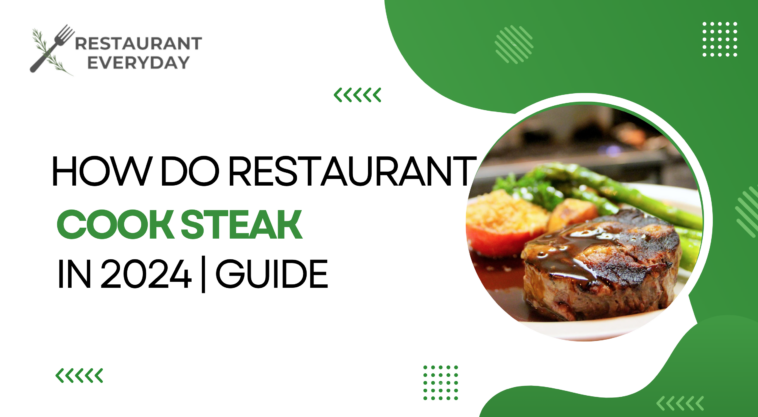Introduction: How do Restaurants Cook Steak
In today’s culinary landscape, mastering the art of cooking steak to perfection is a pursuit cherished by many. The importance of achieving that ideal balance of juiciness, flavor, and tenderness cannot be overstated. Whether you’re a seasoned chef or an amateur enthusiast, the allure of replicating the succulence and richness of restaurant-quality steak at home is undeniable.
Few dishes evoke the same anticipation and delight in gastronomy as a perfectly cooked steak. The sizzling sound, the mouthwatering aroma, and the rich, savory flavor—all come together in a harmonious symphony that tantalizes our taste buds. But have you ever wondered about the culinary magic that takes place behind the scenes in restaurants to achieve that flawless steak?
The purpose of this article is to delve into the intricacies of cooking steak to perfection. We’ll explore various techniques, from selecting the right cut of meat to mastering the art of seasoning and grilling. Additionally, we’ll discuss the significance of temperature control and resting periods in ensuring that every bite is a symphony of flavors.
Whether you prefer your steak rare, medium-rare, or well-done, there’s a science behind achieving your desired level of doneness while preserving the meat’s natural juices and tenderness. Through this exploration, you’ll gain insights and tips to elevate your steak-cooking skills, transforming your home kitchen into a gourmet steakhouse.
Unveiling the Culinary Symphony: A Journey into the Art of Cooking Steak
Join us on a culinary expedition as we peel back the layers and delve into the secrets of how restaurants master the art of cooking steak. From selecting the finest cuts to learning the perfect sear, this exploration promises to demystify the steak cooking process, providing insights that will elevate your home cooking to a whole new level.
Get ready to embark on a journey where flavor and technique converge, unlocking what makes a steak exceptional.
Understanding Steak Cuts and Quality:
Understanding steak cuts and quality is essential for achieving culinary excellence. Various cuts, such as ribeye, filet mignon, and sirloin, offer distinct flavors and textures. Factors like marbling, aging, and grading significantly impact steak quality, influencing taste and tenderness.
Marbling, the distribution of fat within the meat, enhances flavor and juiciness. Aging allows enzymes to break down muscle fibers, resulting in a more tender steak. Grading systems, like USDA Prime, Choice, and Select, provide insights into a steak’s quality based on factors like marbling and tenderness.
The art of cooking steak:
The journey into the art of cooking steak begins with a crucial first step: selecting the perfect cut of beef. Just as a painter carefully chooses their palette of colors, chefs meticulously consider the type and quality of the steak they’ll be working with. The beef world offers diverse cuts, each with a unique texture, marbling, and flavor profile.
Choosing the proper cut and quality
Having embarked on the journey of selecting the perfect cut of steak, the next chapter in the art of culinary mastery unfolds in the preparation process. Preparing the steak is where the magic begins, as chefs employ skill and technique to elevate the chosen cut to its full potential.
From the meticulous seasoning that enhances the natural flavors to the precise marination that imparts depth, each step in the preparation process is a brushstroke on the taste canvas.
Whether it’s a simple seasoning with salt and pepper to let the meat’s intrinsic flavors shine or a more intricate marinade to infuse unique and complementary notes, the choices made during this phase shape the steak’s final symphony of taste.
Join us as we unravel the secrets of preparing a steak that is not just cooked but crafted, exploring the methods, marinades, and seasonings that transform a raw cut into a culinary masterpiece. Through this culinary exploration, you’ll gain insights into the techniques employed by chefs in restaurants worldwide, empowering you to create steak perfection in your kitchen.
Prepare to embark on a flavorful adventure where every step in the preparation process contributes to the symphony of taste that is a well-cooked steak.
Guide: How do Restaurants cook steak
Cooking steak in a restaurant involves several steps to ensure a delicious and perfectly cooked dish. Here’s a general overview of the process:
Selection of Steak:
From the luxurious tenderness of a filet mignon to the robust richness of a ribeye, the choice of cut sets the stage for the culinary masterpiece that is about to unfold.
Join us as we explore the nuances of selecting the ideal steak, examining the impact of factors such as marbling, thickness, and grade. By understanding the artistry behind this initial selection, you’ll be well on your way to creating a steak experience that transcends the ordinary.
Restaurants often choose high-quality cuts of beef, such as ribeye, sirloin, filet mignon, or New York strip. The grade of meat, ranging from Prime to Choice to Select, can also impact flavor and tenderness.
Choosing the right cut is crucial for different cooking methods. For instance, ribeye’s rich marbling makes it perfect for grilling, while filet mignon’s tenderness suits pan-searing. Understanding these nuances empowers home cooks to elevate their steak game and delight their palates with restaurant-quality dishes.
Preparing the Steak
Preparing the perfect steak involves several crucial steps to ensure maximum flavor and tenderness. Firstly, it’s essential to bring the steak to room temperature before cooking. This allows for even cooking and helps prevent the meat from becoming tough.
Next, seasoning techniques play a vital role in enhancing the steak’s flavor profile. Whether it’s a simple salt and pepper rub or a more complex blend of spices, seasoning adds depth and complexity to the dish.
When it comes to flavor enhancement, the debate between marinating and using dry rubs is ongoing. Marinating can impart rich flavors and tenderize the meat, but it requires time. Dry rubs, on the other hand, offer convenience and can create a delicious crust on the steak.
Lastly, for tougher cuts of meat, tenderizing methods such as pounding or using a meat tenderizer can help break down muscle fibers, resulting in a more tender steak. By mastering these preparation techniques, you’ll be well on your way to cooking steak perfection.
Steak Cooking Techniques Used by Restaurants:
Grilling: Grilling enhances the steak’s smoky essence while achieving those coveted grill marks requires preheating and patience. Many restaurants use grills for cooking steak. The open flame imparts a distinctive smoky flavor. Chefs often preheat the grill to a high temperature before cooking.
Pansearing: Searing, the process of quickly cooking the surface of the meat over high heat, seals in juices and creates a flavorful crust. In a kitchen, chefs may use a hot pan to sear the steak on the stovetop. This searing method helps create a flavorful crust.
Broiling: Broiling, though less common, offers intense heat from above, resulting in a charred exterior and juicy interior. Some restaurants use broilers to cook steak. Broiling exposes the meat to direct heat from above, creating a caramelized crust.
Sous Vide (optional): Sous vide cooking involves vacuum-sealing steak and slow-cooking it in a water bath, ensuring uniform doneness and unparalleled tenderness. In modern kitchens, some chefs use sous vide cooking before finishing the steak on the grill or in a pan. This method involves vacuum sealing the steak and cooking it in a water bath at a precise temperature.
Lastly, reverse-searing flips the traditional method by first cooking the steak at a low temperature then searing for a perfect crust, yielding consistently succulent results.
Each technique brings its own unique qualities to the table, allowing chefs to craft steak experiences that delight the senses.
Temperature Control and Doneness Levels While Cooking Steak:
Temperature control is the key to mastering the perfect steak, and a meat thermometer is your best friend in this endeavor. Its importance cannot be overstated, as it ensures your steak reaches the desired doneness without overcooking.
Understanding the different doneness levels is crucial. From the rare, with a warm red center, to the well-done, where the meat is fully cooked throughout, each preference requires precise temperature monitoring.
Also Read: How long are restaurant leftovers good for?
To achieve your desired doneness, follow these tips: sear the steak over high heat first, then finish cooking at a lower temperature; allow the steak to rest after cooking to redistribute juices evenly; and practice patience—avoid cutting into the steak too soon.
With these techniques and a reliable meat thermometer, you’ll consistently cook steak to perfection, impressing even the most discerning palates.
The desired level of doneness (rare, medium rare, medium, medium well, well done) influences the cooking time. Chefs often use a meat thermometer to ensure accuracy.
Common temperature ranges for doneness:
Rare: 120125°F (4952°C)
Medium Rare: 130135°F (5457°C)
Medium: 140145°F (6063°C)
Medium Well: 150155°F (6668°C)
Well Done: 160°F (71°C) and above
Resting and Serving
Resting steak after cooking is crucial to allow the juices to redistribute, ensuring optimal flavor and tenderness. Slice steak against the grain for maximum tenderness and presentation.
After cooking, the steak is allowed to rest for a few minutes. This redistributes the juices, ensuring a juicy and flavorful result.
Proper slicing techniques for presentation
The steak is often sliced against the grain before being plated. Some restaurants may add finishing touches, such as a sauce drizzle, a compound butter pat, or a sprinkle of fresh herbs. Every chef may have variations and techniques, but these general steps provide an overview of how many restaurants cook steak.
Whether you’re hosting a dinner party or enjoying a cozy meal at home, these serving suggestions will elevate your steak experience to new heights.
Also Read: Can you bring Food on a Plane?
Conclusion: How do Restaurants cook steak
As we conclude our journey into cooking steak, we find ourselves at the final act—the presentation. Just as an artist carefully frames their masterpiece, chefs put the finishing touches on their culinary creations with thoughtfully chosen garnishes and serving suggestions. These elements add visual appeal and enhance the overall dining experience, ensuring that every aspect of enjoying the steak is a feast for the senses.
From vibrant herb garnishes that provide freshness to carefully crafted sauces that complement the meat’s richness, the world of garnishes is a playground for creativity.
We’ve explored how chefs artfully balance flavors, textures, and colors to create a visually stunning and gastronomically satisfying plate. Beyond the plate, the choice of sides, accompaniments, and even the right wine can further elevate the steak experience.
In this culinary expedition, we’ve uncovered the secrets of selecting the proper cut, mastering the art of preparation, and enhancing the final presentation. Armed with these insights, you can embark on culinary adventures, creating steaks that transcend the ordinary and genuinely express your culinary artistry.
So, set your table, gather your ingredients, and let the symphony of flavors begin—an ode to the timeless and delectable art of cooking steak.




